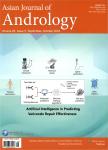AMP-activated kinase in human spermatozoa: identification, intracellular localization, and key function in the reRulation of sperm motility
AMP-activated kinase in human spermatozoa: identification, intracellular localization, and key function in the reRulation of sperm motility作者机构:Research Group of Intracellular Signalling and Technology of Reproduction (SINTREP) School of Veterinary Medicine University of Extremadura Caceres Spain Assisted Reproduction Unit at the-Minimally Invasive surgery Center Jesos Uson (CCMIJU) Caceres Spain Norba Clinic Caceres Spain Research Group of Reproduction and Embryo Development (REDES) University of Extremadura Badajoz Spain Extremadura Institute of Assisted Reproduction (IERA) Badajoz Spain.
出 版 物:《Asian Journal of Andrology》 (亚洲男性学杂志(英文版))
年 卷 期:2017年第19卷第6期
页 面:707-714页
核心收录:
学科分类:0710[理学-生物学] 07[理学] 071009[理学-细胞生物学] 09[农学] 0901[农学-作物学] 090102[农学-作物遗传育种] 071002[理学-动物学]
基 金:supported by the Grant from Mutua Madrilena Spain and by regional Grants from the Government of Extremadura and FEDER Spain
主 题:AMP-activated kinase human spermatozoa immunolocalization sperm motility sperm quality
摘 要:AMP-activated kinase (AMPK), a protein that regulates energy balance and metabolism, has recently been identified in boar spermatozoa where regulates key functional sperm processes essential for fertilization. This work's aims are AMPK identification, intracellular localization, and their role in human spermatozoa function. Semen was obtained from healthy human donors. Sperm AMPK and phospho-Thr172-AMPK were analyzed by Western blotting and indirect immunofluorescence. High- and low-quality sperm populations were separated by a 40%-80% density gradient. Human spermatozoa motility was evaluated by an Integrated Semen Analysis System (ISAS) in the presence or absence of the AMPK inhibitor compound C (CC). AMPK is localized along the human spermatozoa, at the entire acrosome, midpiece and tail with variable intensity, whereas its active form, phospho-Thr172-AMPK, shows a prominent staining at the acrosome and sperm tail with a weaker staining in the midpiece and the postacrosomal region. Interestingly, spermatozoa bearing an excess residual cytoplasm show strong AMPK staining in this subcellular compartment. Both AMPK and phospho-Thr172-AMPK human spermatozoa contents exhibit important individual variations. Moreover, active AMPK is predominant in the high motility sperm population, where shows a stronger intensity compared with the low motility sperm population. Inhibition of AMPK activity in human spermatozoa by CC treatment leads to a significant reduction in any sperm motility parameter analyzed: percent of motile sperm, sperm velocities, progressivity, and other motility coefficients. This work identifies and points out AMPK as a new molecular mechanism involved in human spermatozoa motility. Further AMPK implications in the clinical efficiency of assisted reproduction and in other reproductive areas need to be studied.



